Alienware 18 Gaming Notebook Review
by Dustin Sklavos on September 16, 2013 12:00 PM ESTI'll admit we're getting a pretty solid workout with the NVIDIA GeForce GTX 780M. There are reasons, though. First, the 780M's performance has been very inconsistent since it launched. While some notebooks just needed driver updates (like the Alienware 18), most needed a BIOS update and driver update after the fact. And there's no getting around the fact that the 780M seems to be just plain underperforming. Is part of that due to Haswell? Certainly; for gamers, Haswell as an upgrade over Ivy Bridge is disappointing to say the least. But I suspect there's BIOS and/or driver tweaking still yet to be done to bring the 780M in line with where it really ought to be.
The other reason is that AMD just plain didn't show up to this party. There's a Radeon HD 8970M on the market, but AMD's Enduro is still a bit of a mess, and the 8970M itself is just a rebrand of the 7970M, a chip which already has a hard time competing with the 680M. If I were a betting man I'd expect actual competition to the 780M to materialize sometime in October or November. Hopefully the 780M's issues will have been completely ironed out by then.
Of course, with all that said, the 780M still works pretty well, and NVIDIA's SLI technology is incredibly sound and sturdy. The Alienware 18 boasts dedicated cooling for each GPU and the CPU, and the Intel Core i7-4900MQ should give the two 780Ms plenty of breathing room.
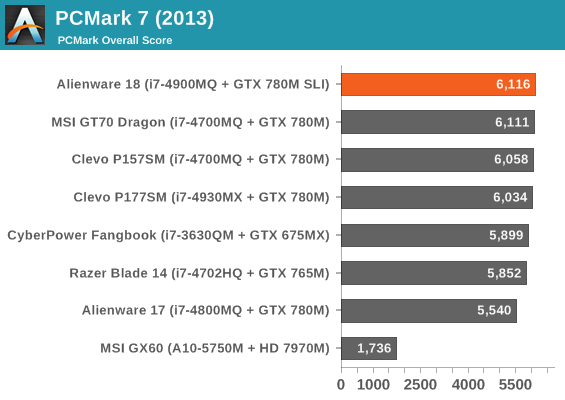
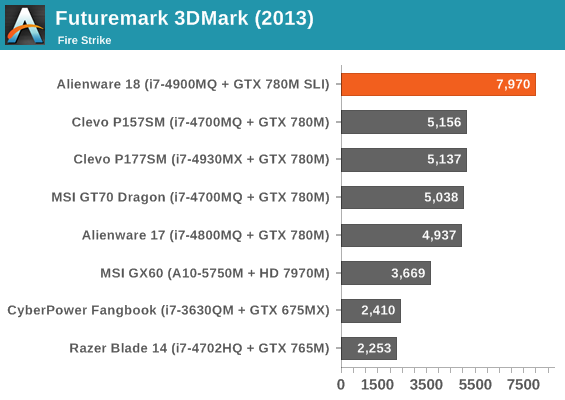
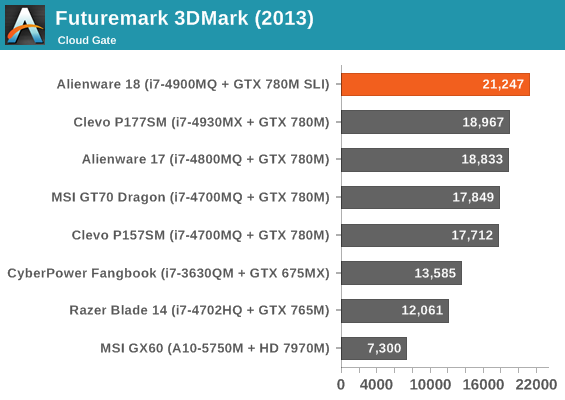
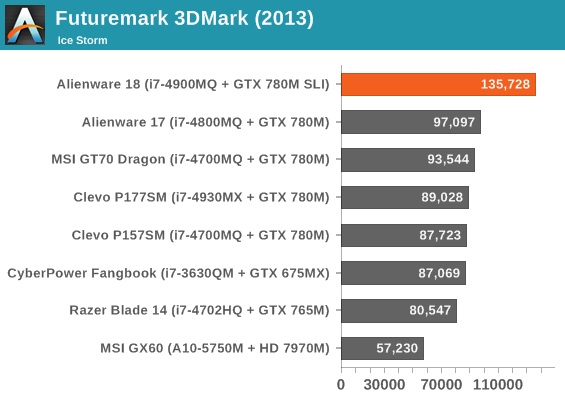
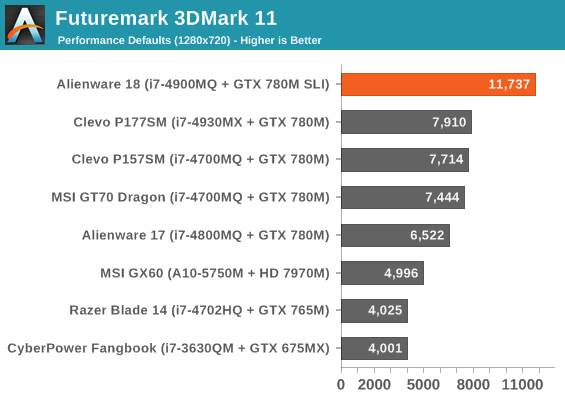
The Futuremarks are as kind to the Alienware 18 as they ought to be. What I want to point out is the PCMark 7 score. The MSI GT70 Dragon we tested is using three SSDs in RAID 0 while the Alienware 18 has to "make do" with a single 512GB (though you can certainly put multiple SSDs into it and stripe them), yet their PCMark 7 scores (a benchmark notoriously SSD friendly) are almost identical. While modern SSDs are hitting bandwidth limitations on SATA, I feel like you'd be hard pressed to really notice a difference with higher throughput in any practical applications.
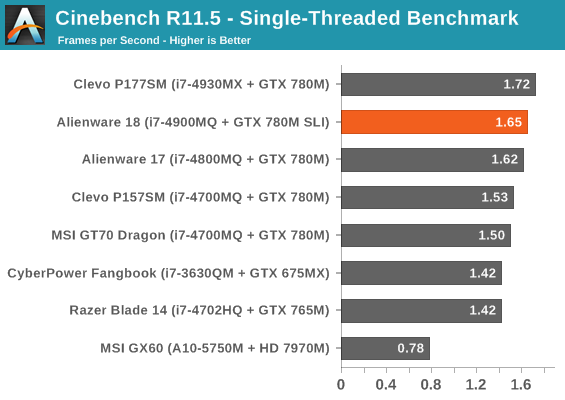
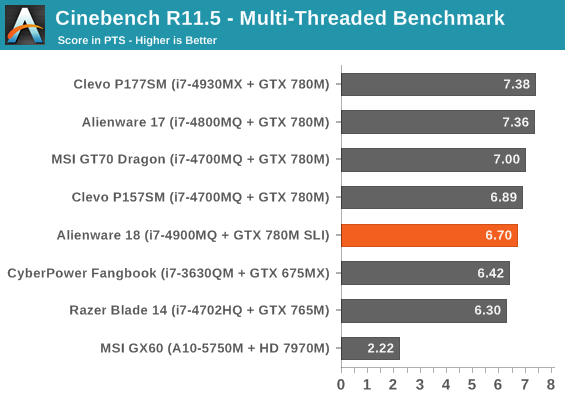
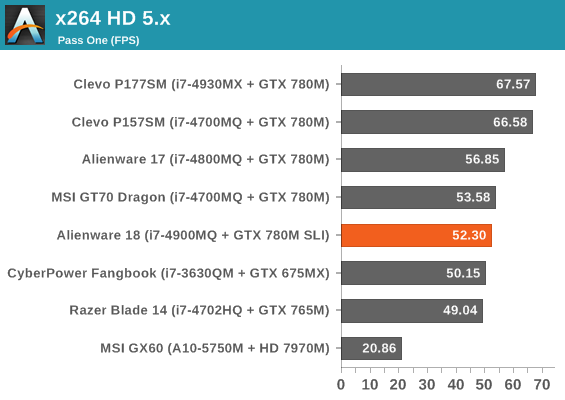
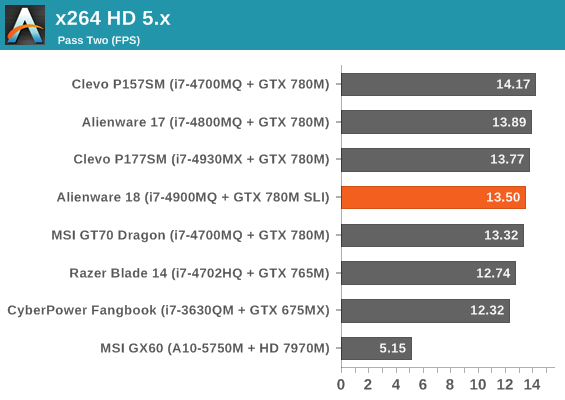
I'd be interested in figuring out why Haswell is underperforming in the Alienware notebooks, though. In our synthetics, the Alienware 17 and now the 18 just aren't stacking up where they ought to be, especially our x264 testing. Performance isn't alarmingly poor, but they're definitely having trouble keeping up with Clevo's Haswell implementations.










60 Comments
View All Comments
Pathfindercod - Monday, September 16, 2013 - link
Ive had my 18 for a month and my 14 for 3 weeks. My 18 has the 4800 cpu, 780 sli, 16gb ram, I took out the stock 750gbd hd, put two 512gb Samsung 840 pros' and a Plextor 256gb mSATA. I absolutely love this 18, it is pretty amazing for a laptop. My 14 is quite impressive for a 14" laptop, the 1080p panel is great IMO. I did calibrate them with my Spyder 4 Elite, but they are great panels in both of the machines.Pathfindercod - Monday, September 16, 2013 - link
Oh and Alienware cant seem to keep up with demand... This is my first real Alienware computer and im happy i decided to get one.nathanddrews - Monday, September 16, 2013 - link
Conspiracy!Notice how the 780M scores 7,970 points in Fire Strike? 7970. Yeah, right!
(tongue planted firmly in cheek)
xTRICKYxx - Monday, September 16, 2013 - link
I wish the panel was 2560x1440 or something high-res in that respect. Even a 120hz panel would have been better than the IPS.DanNeely - Monday, September 16, 2013 - link
In most games it looks like 780m SLI wouldn't be fast enough to feed either of those options reasonably well. Only half the games scored well above 60 FPS, and since going to 2560x1440 would roughly double the amount of work very few would be playable at the higher resolution.Depending on what, if anything, the new consoles do to put upward pressure on the performance of top level systems we might be able to do that with next years die shrunk mobile GPUs. Then again if new games end up doubling the amount of GPU they demand we'll still be stuck in the same situation. Maybe nVidia/AMD will get 3way GPU support working well enough to create even more massive laptops that could do it in that case.
kogunniyi - Monday, September 16, 2013 - link
How does your impression of the build quality of the 17/18 stack up with that of any of the workstations you have tested?boeush - Monday, September 16, 2013 - link
In concordance with what xTRICKYxx posted previously, I also find the measly 1080p resolution on an 18"+ laptop monitor, just plain offensive. Never mind that it's a glossy monitor, and with a rather ho-hum color gamut and contrast to boot -- in a system that (when fully tricked out) costs $4,000+ (not including tax and shipping...) The monitor on this thing is nothing short of a flat-out insult.Never mind that the chassis is over-sized for both the monitor and the keyboard (or, conversely, the monitor and the keyboard are under-sized for the chassis.)
And really, who the hell needs 32 GB or RAM? And who'd need the hard drive when there's 512 GB of SSD available? These seem like pretty stupid choices to me. I'd rather have that space taken up by a larger battery (maybe something like 50% larger): lord knows, the chassis is big enough to accommodate it!
On the whole, this design seems like a bunch of cost-cutting compromises and design block reuse, in a system that's supposed to be a top-of-the-range, aspirational, halo product. FAIL
boeush - Monday, September 16, 2013 - link
Oh and also, forgot to mention: why, WHY, would anyone configure a premium performance-oriented system like this, with DDR3L-1600 memory??Seems to me, 2400 ought to be the minimum here (and yes, 16 GB of RAM would still quite suffice at least for the next 5 years or so...)
DanNeely - Monday, September 16, 2013 - link
Probably because that's the fastest sodimm widely available. Mobile memory isn't generally available in faster than official JDEC speeds. I just checked Newegg, they had 84 sodimm items at 1600, 9 at 1833, and none at higher speeds. The low number of available sodimms at that speed means Dell would probably be concerned about sustaining availability if they offered them. The lower voltage doesn't really do much in laptop as power hungry as this, but it doesn't hurt either; and it's probably significantly cheaper for Dell to use the same 8GB dimms in this beast as the other 99% of 16GB laptops where the lower voltage is a benefit.boeush - Monday, September 16, 2013 - link
Well, DELL being an OEM (with rather large production volumes), ought to be able to source the memory it needs directly from manufacturers -- without having to go through retail channels (and eat the retail markup) like Newegg. Apple does it, and its customers pay the premium for the resulting premium products. That arrangement makes sense. Alienware wants to charge a premium for its product, but cuts corners on design costs? FAILAlso, even if 2400 is for some reason impractical using today's manufacturing processes, at least provide 1833 if not 2133 -- both of which are actually available even through the retail channel (and really, there is no point in going with low-voltage memory on a performance-oriented laptop with friggin' SLI...)